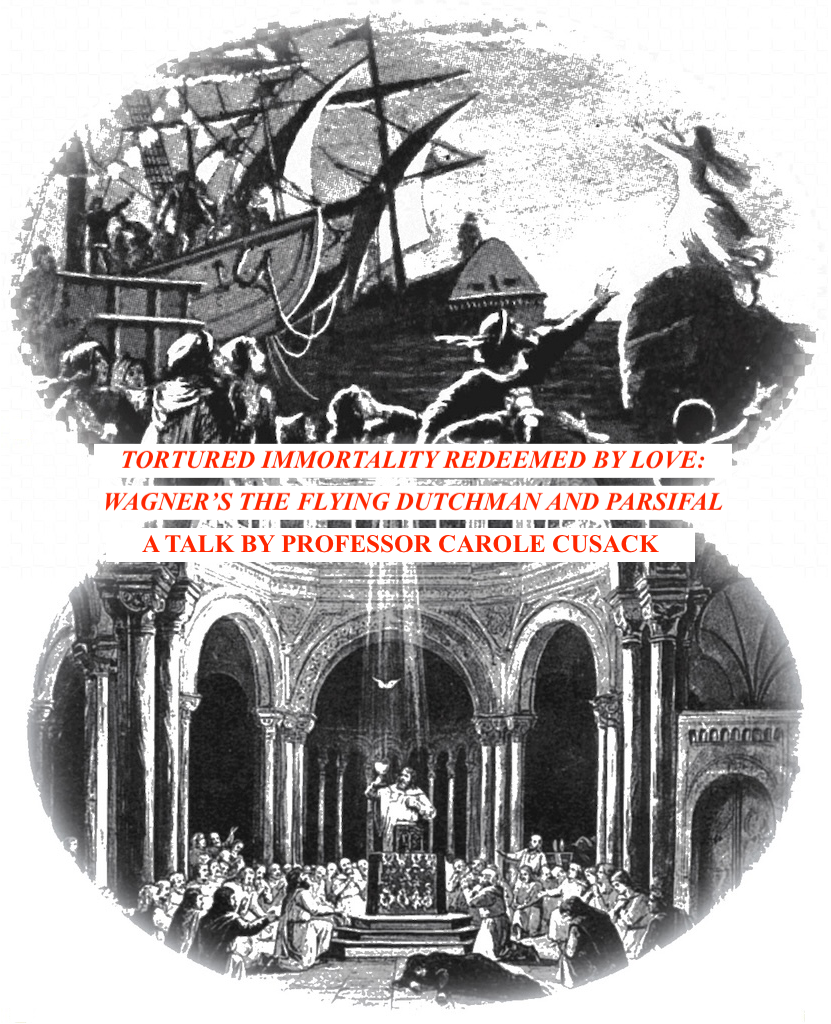SUNDAY 20 JULY 2025
TORTURED IMMORTALITY REDEEMED BY LOVE: WAGNER’S THE FLYING DUTCHMAN AND PARSIFAL, BY PROFESSOR CAROLE M CUSACK

12.00pm:
DVD – Salzburg Festival 2013 – Parsifal, Act 3
2.00pm:
Talk by Professor Carole M Cusack on
‘Tortured Immortality Redeemed by Love:
Wagner’s The Flying Dutchman and Parsifal’
Venue:
The Goethe Institut, Event Hall (upstairs),
90 Ocean Street (cnr Jersey Road), Woollahra
Tickets:
$25 members, $35 non-members, $10 full-time students
ABOUT THE DVD
The 2013 Salzburg Easter Festival featured a new production of Wagner’s opera “Parsifal,” conducted by Christian Thielemann with the Staatskapelle Dresden. The production was directed by Michael Schulz and featured a cast including Johan Botha (Parsifal), Michaela Schuster (Kundry), Stephen Milling (Gurnemanz) and Wolfgang Koch (Amfortas/Klingsor). The performance was recorded live at the Großes Festspielhaus in Salzburg on 23 March 2013. It was part of the inaugural season of the Salzburg Easter Festival under Thielemann’s artistic direction. The production was noted for its unusual staging and the strong musical interpretation by Thielemann and the Staatskapelle Dresden.
ABOUT PROFESSOR CUSACK
Carole M. Cusack is Professor of Religious Studies at the University of Sydney. She trained as a medievalist and her doctorate was published as Conversion Among the Germanic Peoples (Cassell, 1998). She now researches primarily in contemporary religious trends and Western esotericism. Her books include (with Katharine Buljan) Anime, Religion and Spirituality: Profane and Sacred Worlds in Contemporary Japan (Equinox, 2015), Invented Religions: Imagination, Fiction and Faith (Ashgate, 2010), and The Sacred Tree: Ancient and Medieval Manifestations (Cambridge Scholars Publishing, 2011). She edited (with John W. Morehead and Venetia Laura Delano Robertson) The Sacred in Fantastic Fandom: Essays on the Intersection of Religion and Pop Culture (McFarland, 2019) and (with M. Afzal Upal), Handbook of Islamic Sects and Movements (Brill, 2021). She edits the journals Alternative Spirituality and Religion Review (PDC, USA), Literature & Aesthetics (journal of the Sydney Society of Literature and Aesthetics), and Journal of Daesoon Thought and the Religions of East Asia (Daejin University, South Korea).
ABOUT THE TALK
The Flying Dutchman (1843) and Parsifal (1882) are united by characters who are doomed to wander the earth as penance for unexpurgated sin (a blasphemous oath by the Dutchman, and Kundry’s laughter at Christ on the cross). Both are identified with the Wandering Jew of Christian folklore, who mocked the crucified Jesus and was doomed to deathless wandering. Both are saved by Christ figures; Senta sacrifices herself to break the curse that binds the Dutchman, and Parsifal baptises Kundry, who dies a saved Christian, on Good Friday, the commemoration of Christ’s atonement. The Jewish identity of the Dutchman and Kundry is a serious impediment; that Richard Wagner held antisemitic views is well-known. Yet what is more interesting is that over almost 40 years there is an explicit shift towards more conventional Christian imagery evident in Parsifal. Wagner thought his era was one in which religion had lost power, and art was needed to replace it. Wagner is thoroughly modern for he, to quote David Huron, creates a “music of hunger, rather than of fulfilment” (2006). The Flying Dutchman is a symbolic opera; but Parsifal is a Bühnenweihfestspiel (“festival work for the initiation of a stage”) intended to redeem its audience.
